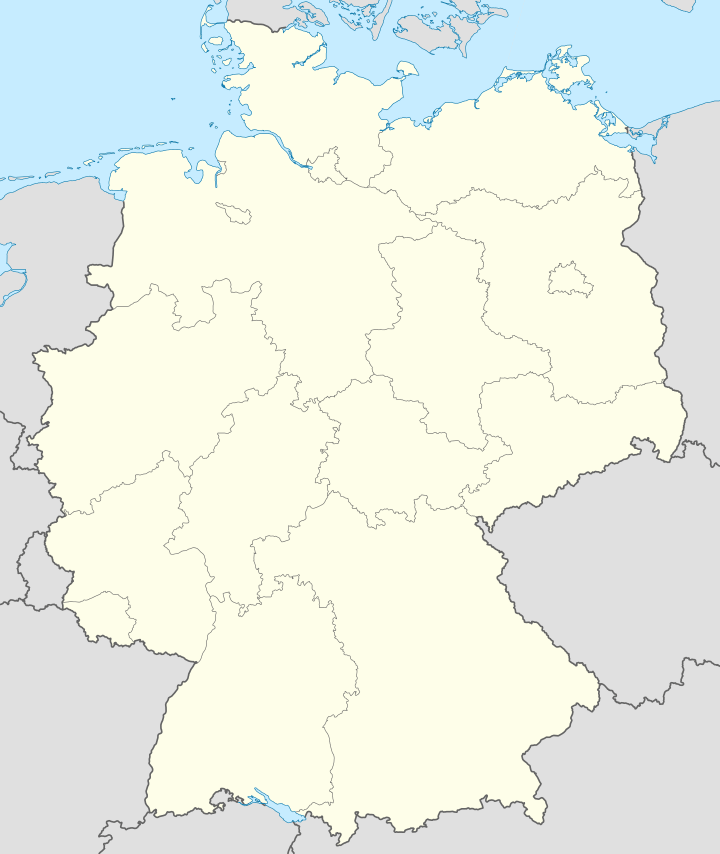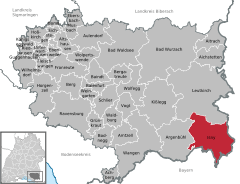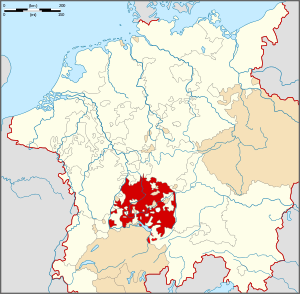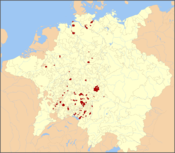Isny im Allgäu
| Isny im Allgäu | ||
|---|---|---|
 | ||
| ||
 Isny im Allgäu | ||
Location of Isny im Allgäu within Ravensburg district 
 | ||
| Coordinates: 47°41′31″N 10°2′22″E / 47.69194°N 10.03944°ECoordinates: 47°41′31″N 10°2′22″E / 47.69194°N 10.03944°E | ||
| Country | Germany | |
| State | Baden-Württemberg | |
| Admin. region | Tübingen | |
| District | Ravensburg | |
| Government | ||
| • Mayor | Rainer Magenreuter (Ind.) | |
| Area | ||
| • Total | 85.37 km2 (32.96 sq mi) | |
| Population (2012-12-31)[1] | ||
| • Total | 13,186 | |
| • Density | 150/km2 (400/sq mi) | |
| Time zone | CET/CEST (UTC+1/+2) | |
| Postal codes | 88316 | |
| Dialling codes | 07562 | |
| Vehicle registration | RV | |
| Website | www.isny.de | |
Isny im Allgäu is a town in south-eastern Baden-Württemberg, Germany. It is part of the district of Ravensburg, in the western, Württembergish part of the Allgäu region.
Isny was a Free Imperial City (Freie Reichsstadt) until the mediatisation of 1803.
History

During the three centuries following its origin in 1042, it was a commercial center controlled and exploited by various competing feudal lords. In the 13th century, Isny's merchants built a fortification system to protect the town from marauders and rival feudal rulers. The town is still partially surrounded by the city walls and moat that were built during these early turbulent times.
 Isny before and after the great fire of 1631; St. George's Abbey church is the building with two spires to the right, with the rest of the monastery adjacent. Merian, Topographica Sueviae, 1643–56 |
After three centuries of domination by feudal lords and territorial rulers, Isny's middle class was able to purchase the town's independence in 1365. Isny's status as an Imperial city made it a self-governing republic in which the city government was elected by propertied residents and in which the guild system thrived. In 1529, Isny's Protestant minority took the city council and voted to make the town Protestant and the Nikolaikirche became the town's main Protestant church.In 1803, the Kingdom of Württemberg allowed the Catholic majority to once again move to the city. In 1889, the majority of urban residents was Catholic (1139 ev / 1444 Cath.).
Isny enjoyed a vibrant economy, based primarily on linen production, until competition from abroad, the devastation of the Thirty Years' War, and a series of fires and plagues brought production to a halt in the 17th century. The town experienced a revival after the end of World War II, when a rehabilitation center for war veterans was established there. Fortunately, Isny emerged from the war largely undamaged, and has since become a popular destination for vacationers and resort-goers.

| Imperial City of Isny in the Allgäu | |||||
| Reichsstadt Isny im Allgäu | |||||
| Free Imperial City of the Holy Roman Empire | |||||
| |||||
| Capital | Isny im Allgäu | ||||
| Government | Republic | ||||
| Historical era | Early modern period | ||||
| - | Abbey founded by Count of Altshausen-Veringen |
1096 | |||
| - | Isny gained town rights | 1235 | |||
| - | Became Imperial city by purchasing Vogtei from Stewards of Waldburg |
1365 | |||
| - | Protestant Reformation | 1529 | |||
| - | Abbey gained Imperial immediacy |
1781 | |||
| - | City mediatised and abbey secularised to Princely County of Quadt-Wykradt |
1803 | |||
| - | City and abbey mediatised to Kgdm Württemberg |
1806 | |||
| Today part of | | ||||
International relations
Isny im Allgäu is twinned with:
-
 Andrychów, Poland
Andrychów, Poland -
 Notre-Dame-de-Gravenchon, Seine-Maritime, France
Notre-Dame-de-Gravenchon, Seine-Maritime, France -
 Street, Somerset, United Kingdom
Street, Somerset, United Kingdom -
 Flawil, St Gallen, Switzerland
Flawil, St Gallen, Switzerland -
 Sotkamo, Oulu, Finland
Sotkamo, Oulu, Finland
References
- ↑ "Gemeinden in Deutschland mit Bevölkerung am 31.12.2012 (Einwohnerzahlen auf Grundlage des Zensus 2011)". Statistisches Bundesamt (in German). 12 November 2013.
External links
| Wikimedia Commons has media related to Isny im Allgäu. |
| Wikisource has original text related to this article: |
- Isny Tourist website (German)
- Photographs of Isny
| ||||||||||||||||
| |||||||||||||||||||||||||||||
| ||||||||



